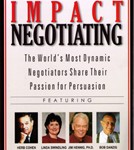Win-Win Negotiation is a Must
Editor’s note: Linda Swindling is a frequent contributor to this blog.
Win-Win negotiations were once a goal but are now a necessity. Today’s times demand a Win-Win approach to achieve durable agreements.
Offerings have expanded not retracted
Negotiating parties have a greater choice of partners. If one party doesn’t worry about your interests, you usually have the ability to choose another who does. Now, if an agreement doesn’t meet the needs and wants of each of the parties, you need just pick up a phone or surf the internet to find someone else to fill the requirement.
The market is demanding customized solutions
Look at sales training. Scripts are out. Formulaic procedures to show benefits and push standardized offerings have been replaced by consultative selling. Consultative selling focuses on customized requirements and meeting individual needs.
Forcing agreements doesn’t work for the long haul
So many people say they understand the need for Win-Win but then diligently fight against it. They don’t share information and compete instead of solving problem. They don’t make the first offer and take unrealistic positions. This attempt to conquer or a Win-Lose approach destroys long-term relationship building. Applying force, going to someone’s superior and attempting to just deal with decision makers does not fit in the current professional environment.
Win-Win negotiation strives for all the parties involved to get a better agreement by collaborating to meet each party’s interests. If the other party feels like its interests are represented or they made a bad deal, they may try to sabotage it or look for your non-compliance. People are far more likely to support something they created.
While Win-Win is an easy concept to intellectualize, it can be difficult to implement. You may need to remind those involved about the shared reasons for participation in the agreement or venture or to help the others achieve their results before ensuring you receive yours. In the end, you want an agreement people will support, have loyalty around and encourage. Many professionals have to influence ‘internal customers’ to receive data, supporting materials, accounting information, and implementation help. These internal departments or teams have many people who are requesting the same type of information or support. For example, a benefits plan representative may rely on a partner outside the company like a financial advisor or insurance broker to sell the plan to a client’s human resources professional. This same benefits plan representative may need marketing materials from the marketing department to support the sales arm and then different information to inform the client’s employees once the plan is selected. The representative may need to co-ordinate the efforts of the IT department and the client company’s technology department to ensure that technical requirements are met. There may be a training arm for implementing the plan, customer service functions and, of course, billing to ensure payment. Most likely, that benefits representative is under a strict time frame and can only rely on good graces, past dealings, wit and an ability to influence to get those resources aligned correctly.
The differences between influence and traditional negotiations
Like the benefits representative, your success can depend on whether you can influence those people to process your requests first or at a high enough level of quality. You have no power over them and do not want to go around them if possible because you must continue to work with them in the future.
Another common need for influencing is when your company has a partner or partners who are part of your supply chain. Perhaps they are distributors or take your orders or provide your customer support or service the equipment you manufacture. Once again, you do not have control over these other organizations’ performance and they may have competing pulls on their time. However, it is imperative that you persuade and partner effectively to do your job. Influencing effectively may be the only way to enhance performance with these partners.
Anytime you’re working together to promote each other or need to access shared resources you’ll see a need to influence. With the amount of people who are outsourcing services to other companies, locations and even countries, the need to improve persuasion and influencing skills has never been greater.

